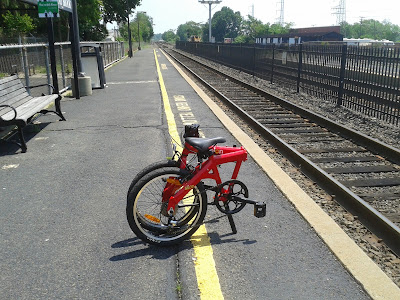 |
| Folded and ready for boarding |
Yes, trains are a great way to get around, except for one thing, what is known as the "Last Mile Problem."
One of the biggest obstacles to getting people to use the train rather than drive is the fact that it's not always easy to get from home to the train station, and then from the train station to your eventual destination. The train can get you close to where you need to be, but unless you happen to work across the street from the railway, you're pretty much on your own.
There have been any number of proposals for dealing with this problem, from improved taxi service to electric skateboards, but one of the simplest and most efficient means of station-to-destination transport always has been, and probably always will be, the bicycle (at least until private jetpacks are practical).
There are three major ways to use a bicycle to get from your train to wherever you plan to work or play:
- Bike Share Programs: While these are relatively new and only available in a few select urban areas, such as Washington DC, bike shares work great for railway commuters. You simply hop off your train, check out a bike, ride it to the check-in point nearest your destination, and go about your day. Obviously, to be practical, this means there has to be both a place to rent a bike at the station and one to return it near where you're headed, but with bike shares becoming increasingly popular, this may be a big part of mass transit's future.
- Bring your own bike on the train: Ride to the station, board the train with your bike, ride home. This is simple in theory but in a lot of cases may be quite complicated. Many rail lines have restrictions on bicycles during peak transit hours (aka "when you have to go to work"), which make figuring out your schedule something of a challenge. The easiest way to get around this is to use a folding bike, which are almost universally allowed on public transport.
- Leave a bike at the station: If you ride the same train every day, and only need an extra set of wheels at one end of the trip, simply parking a bike at the station might be the way to go. A nicer bike should be kept in a bike locker, but if that's not an option, it's best to get yourself a beater bike, as train stations tend to be hotspots for bike theft.
Bicycles and trains complement each other extremely well, and many areas are starting to realize that, adding special cars and fittings to encourage cycling, however, there's still a long way to go in a lot of areas before we can all simply roll on and off the train without any hassle, so take some time and plan ahead.
No comments:
Post a Comment